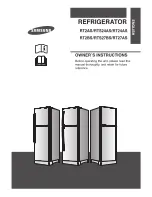
Instructions for Use
37
•
Put a suitable vessel under the frezing
compartment to collect the defrost water.
Leave the door of the compartment open to
accelerate defrosting.
•
Avoid using defrosting sprays, as they may
cause damage to the plastic parts and may
be hazardous to health.
Cleaning the Appliance
Disconnect the power supply before
cleaning the appliance.
Do not use coarse or aggressive cleaning
agents as you can damage the surface.
Be careful to remove any cleanser agent
remaining after cleaning.
•
Clean the
exterior
with water and detergent.
Varnished surfaces are cleaned with soft
cloth and an alcohol based cleaning agent
(for example glass cleaners). You may also
use alcohol (ethanol or isoprophylic alcohol).
The application of abrasive and specially
aggressive cleaners, such as the stainless
steel cleaners, is not appropriate for the
cleaning of plastic and coated parts.
•
Remove the
detachable accesories
in the
interior of the appliance and clean it with
water and liquid detergent. Plastic parts
cannot be washed in washing machine.
•
Wash the
interior
of the appliance with
lukewarm water, in which you added one or
two spoonfuls of vinegar.
•
Every now and then wipe the
condenser
on
the rear wall. Use soft non-metal brush or
vacuum cleaner.
•
Do not forget to clean also the defrost water
receptacle
above the refrigerator
compressor (do not remove the receptacle).
After cleaning, connect the appliance to power
supply and reload the packages.
Switch Off the Appliance When Not In
Use
If you do not intend to use the appliance for a
longer period, set the thermostat knob to the
STOP (0)
position, disconnect the power
supply, take out the foods and defrost and
clean the appliance. Leave the door slightly
open.
Trouble-Shooting Guide
During the service, you can come across some
troubles that in most cases result from
improper handling of the appliance and can
easy be eliminated.
The Appliance Fails to Operate After
connecting to the Mains Supply
•
Check the supply in the outlet socket and
make sure the appliance is switched on
(thermostat in operating position).
Continuous Operation of the Refrigerating
System
•
the door was frequently opened or it was left
opened for too long;
•
the door is not properly closed (the door may
sag, the gasket may be polluted or
damaged);
•
perhaps you have overloaded the appliance
with fresh foods;
•
The reason may be inadequate ventilation of
the compressor and condenser (assure
adequate air circulation and wipe off the
condenser);
•
Continuous operation button activated (see
section Freezing of Food).
Ice Formation on the Inner Rear Wall
As long as the defrost water runs to the
channel and through the opening to the drain

































